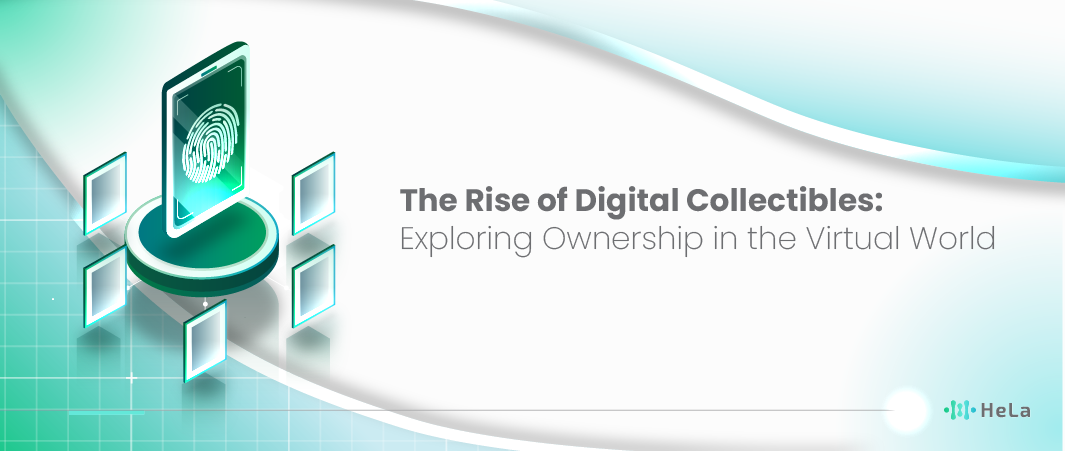In an increasingly digital world, the concept of ownership is evolving. Digital collectibles, unique assets that exist solely in virtual form, are revolutionizing the way people think about value, rarity, and personal possessions online. Whether it’s digital art, virtual real estate, or rare in-game items, digital collectibles represent a new frontier in ownership. Powered by blockchain technology, these assets offer verifiable proof of authenticity and ownership, allowing collectors to buy, sell, and trade with confidence.
This new breed of collectible taps into the growing interest in virtual environments, where individuals seek to express themselves, invest, and even earn income. From avid gamers to art enthusiasts, the appeal of owning something unique, scarce, and digitally transferable is catching on fast. As we continue to spend more of our time in virtual spaces, digital collectibles are poised to play an increasingly central role in both our digital and real-world lives.
What is a Digital Collectible?

Digital collectibles are unique, non-tangible assets that exist in the digital realm. These assets are represented by tokens on blockchain networks, giving them uniqueness, ownership, and traceability. Each digital collectible, whether an image, video, piece of music, or virtual property, is often powered by non-fungible tokens (NFTs), but they can take many forms depending on the platform or ecosystem.
Digital collectibles are gaining rapid popularity due to their exclusivity and the fact that they can be traded, owned, or used across multiple platforms. They represent a new wave of online ownership, similar to how people collect physical items like stamps or coins, but they are entirely digital and often verifiable on blockchain networks. In this article, we’ll dive deeper into what makes digital collectibles special, why they matter, how they’re created, and where they can be used.
The Evolution of Digital Collectibles
Digital collectibles didn’t just appear out of nowhere. Their roots can be traced back to the early internet days, when people began collecting digital assets like avatars, domain names, or even rare items in video games. Over time, as technology evolved, the concept of digital ownership became more sophisticated.
One of the earliest forms of digital collectibles was in the gaming world, where players would spend hours collecting in-game items or skins. These digital assets were confined to the specific games they were earned in, but they signaled the early stages of a much larger movement.
Read More: Top 15 Examples of Custom Software Development in 2024
Blockchain technology later introduced the concept of true ownership over digital assets, thanks to NFTs. NFTs allowed collectors to own rare digital items that couldn’t be copied or replaced. This development unlocked the potential for artists, creators, and developers to create unique, traceable, and transferable digital goods.
Digital collectibles are part of this larger shift from a physical to a digital world, offering new ways to own, trade, and value digital assets.
How Digital Collectibles Work

Digital collectibles typically rely on blockchain technology. Blockchain is a decentralized ledger system where transactions, ownership records, and other data can be securely stored and verified by a network of computers. For digital collectibles, this means that once you own a digital item, it’s verifiably yours and can be traced to your account across the blockchain.
A popular method for creating digital collectibles is through non-fungible tokens (NFTs), which exist on blockchains like Ethereum, Solana, or Flow. Unlike cryptocurrencies such as Bitcoin or Ethereum (which are fungible and identical), NFTs are one-of-a-kind tokens that represent something unique.
Here’s how digital collectibles typically work:
- Creation: Creators produce a digital asset, which can be artwork, music, a video clip, or an in-game item. This digital asset is then “minted” on a blockchain as an NFT.
- Ownership: Once minted, the NFT gets a unique identifier on the blockchain, and anyone who purchases or is given the collectible becomes its verifiable owner.
- Trading and Selling: Owners of digital collectibles can trade or sell them on various marketplaces. When sold, the blockchain updates ownership records to reflect the change in the new owner.
- Usage: Some digital collectibles can be used in virtual environments, games, or other platforms, providing additional value beyond just owning the item.
Digital collectibles can be anything from virtual trading cards, in-game assets, avatars, or even virtual real estate. The key is that they are verifiably rare and owned by individuals, thanks to the blockchain.
Why Digital Collectibles Matter

So why do digital collectibles hold such a significant place in today’s digital world? There are several reasons why they’re becoming increasingly important and popular among both casual users and seasoned collectors:
- Ownership in the Digital Age: As more of our lives move online, the concept of ownership has expanded beyond physical goods. Digital collectibles allow individuals to own and trade assets in the virtual world, giving a new sense of ownership that fits the digital-first lifestyle many people lead today.
- Monetization for Creators: Digital collectibles offer a new way for artists, musicians, game developers, and content creators to monetize their work. With NFTs, creators can earn revenue not only from the first sale but also from subsequent trades, where they can receive a small percentage of each transaction.
- Scarcity and Rarity: Just like rare physical items such as antiques or limited-edition sneakers, digital collectibles can be scarce. The uniqueness and limited supply of digital items make them highly desirable, often driving up their value in the market.
- Interoperability Across Platforms: Some digital collectibles can be used across multiple virtual platforms or games. For example, a rare avatar skin might be usable in several games or metaverse platforms, adding value to its ownership.
- Social Status and Identity: Digital collectibles, particularly in online communities or the metaverse, have become a way for people to express their status or identity. Owning rare digital items can signal wealth, exclusivity, or membership in a particular community.
Examples and Types of Digital Collectibles
The variety of digital collectibles spans across different industries, from entertainment to real estate. Let’s explore a few types of digital collectibles and their practical examples:
1. Art and Music NFTs
Artists and musicians have embraced digital collectibles, creating limited-edition works that fans can purchase and display. Platforms like OpenSea and Foundation allow artists to mint their work as NFTs and sell it to collectors. Famous examples include Beeple’s $69 million digital artwork sold at Christie’s and musicians like Kings of Leon releasing albums as NFTs.
2. Virtual Real Estate
In the virtual world, platforms like Decentraland and The Sandbox allow users to purchase digital land. These parcels of virtual real estate can be developed, rented, or sold. Just like physical real estate, the value of virtual land can increase based on location, demand, and development within the virtual world.
3. Gaming Assets
Many games have integrated NFTs to give players ownership of in-game assets like weapons, skins, and characters. Games like Axie Infinity, CryptoKitties, and Gods Unchained offer players the ability to collect, trade, and use their NFTs across different gaming experiences. These digital collectibles provide both entertainment and potential financial rewards.
4. Collectible Cards and Sports Memorabilia
Trading cards, whether physical or digital, have long been a popular form of collecting. Platforms like NBA Top Shot offer digital sports collectibles in the form of video clips known as “moments.” These digital cards can be bought, sold, and traded, much like traditional trading cards.
5. Avatar and Wearables
In metaverse platforms and virtual worlds, digital collectibles often come in the form of avatars, clothing, and accessories. People can customize their online personas with rare skins, outfits, and other virtual goods. These items can be valuable not only for their aesthetic appeal but also for their rarity.
The Future of Digital Collectibles
The potential of digital collectibles extends far beyond their current form. As technology advances and more industries adopt blockchain and NFT technologies, the ways in which we interact with digital assets will evolve.
1. Integration with the Metaverse
The metaverse, a collection of interconnected virtual worlds, will likely become one of the most significant areas where digital collectibles thrive. As more people spend time in virtual spaces, the demand for digital goods—whether virtual real estate, wearables, or digital artwork—will grow. In the future, owning digital land, rare avatars, or virtual pets could become as normal as owning a house or car in the real world.
2. Sustainability and Environmental Concerns
One major challenge facing digital collectibles, particularly NFTs, is the environmental impact of blockchain networks. Blockchain technology requires significant computational power, contributing to carbon emissions. However, as the industry moves towards more eco-friendly solutions, such as proof-of-stake consensus mechanisms, this problem may diminish over time.
Read Next: 10 Best Crypto Signals That Prepare You For Next Bull Market
3. Broadening Accessibility
While digital collectibles are currently popular among crypto enthusiasts and collectors, accessibility for mainstream users is still a hurdle. Many people find it difficult to purchase NFTs due to high fees, unfamiliar platforms, or the need to own cryptocurrency. As user-friendly platforms and lower-cost solutions emerge, digital collectibles could reach a much larger audience.
4. Regulation and Security
As with any new market, digital collectibles face potential regulatory challenges. Governments and regulators are beginning to examine how NFTs and digital assets fit into existing financial and securities laws. Additionally, ensuring the security of digital assets, especially as scams and theft become more common, will be crucial to maintaining consumer trust.
5. New Forms of Digital Collectibles
The possibilities for digital collectibles are endless. In the future, we might see more integration of collectibles in augmented reality (AR) or virtual reality (VR). Imagine walking through a virtual gallery wearing AR glasses, where you can see and interact with digital artwork you own.
Conclusion
Digital collectibles represent a transformative shift in how we perceive ownership, creativity, and trade in the online world. From rare digital artworks to in-game assets and virtual real estate, these non-tangible assets provide a way for people to engage with the digital realm in entirely new ways.
As technology evolves and the metaverse becomes more integrated into our lives, digital collectibles will continue to grow in importance and variety. Whether you’re a casual collector, an artist, or a tech enthusiast, the world of digital collectibles offers an exciting frontier for ownership and creativity in the digital age.
Disclaimer: The information provided by HeLa Labs in this article is intended for general informational purposes and does not reflect the company’s opinion. It is not intended as investment advice or recommendations. Readers are strongly advised to conduct their own thorough research and consult with a qualified financial advisor before making any financial decisions.

I am Carina Caringal, a technical writer specializing in blockchain engineering concepts, decentralized systems, crypto infrastructure, and Web3 technologies. My work focuses on analyzing and translating complex technical mechanisms into precise, structured, and insightful content for both developers and non-technical readers who want a deeper understanding of the decentralized ecosystem.
My background in blockchain and cryptocurrency is rooted in years of independent research, continuous learning, and hands-on exploration across multiple protocols and network architectures. I study the underlying mechanics of distributed ledger technology, from consensus algorithms and smart contract logic to network scalability, security models, cryptographic principles, and interoperability frameworks. This technical foundation shapes the way I approach every article, ensuring accuracy, depth, and relevance.
- Carina Caringalhttps://helalabs.com/blog/author/carina-caringal/
- Carina Caringalhttps://helalabs.com/blog/author/carina-caringal/
- Carina Caringalhttps://helalabs.com/blog/author/carina-caringal/
- Carina Caringalhttps://helalabs.com/blog/author/carina-caringal/

